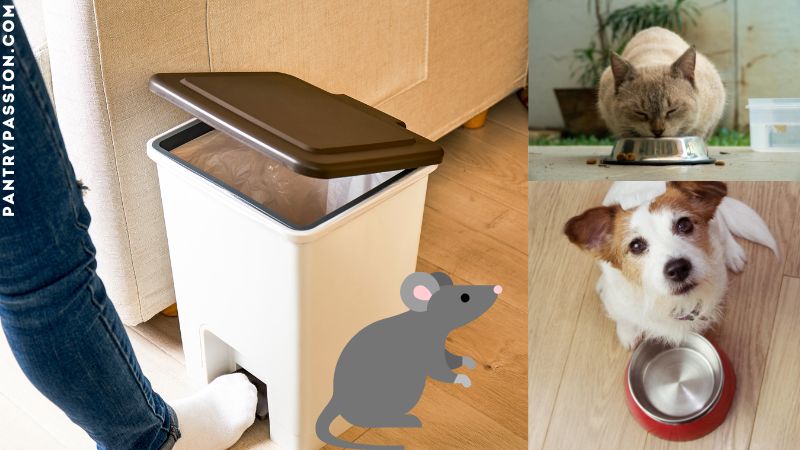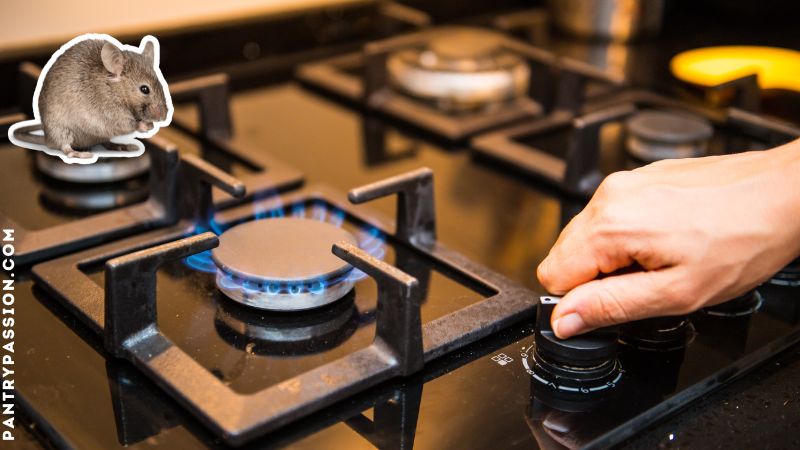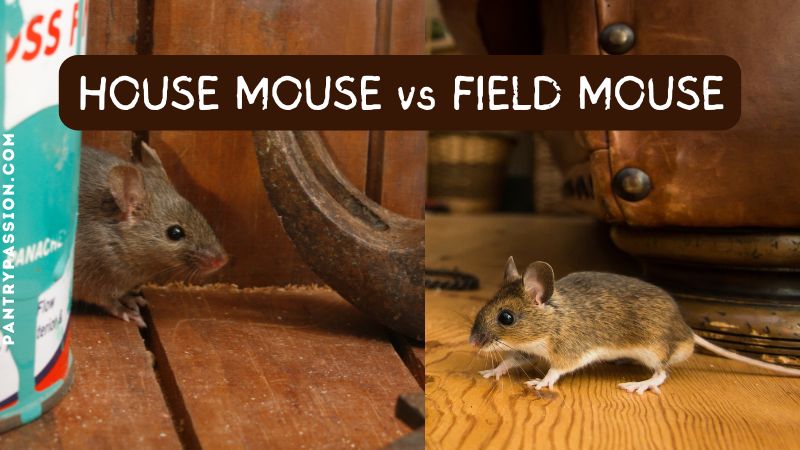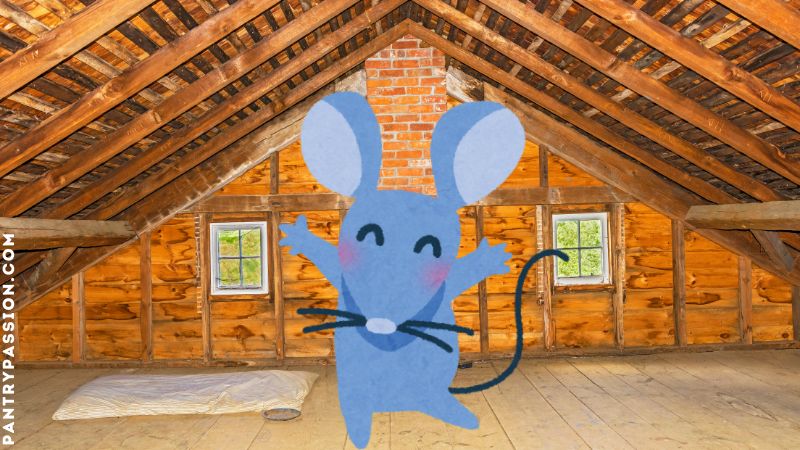The Best Fluffy Pancakes recipe you will fall in love with. Full of tips and tricks to help you make the best pancakes.

Mice in the pantry? Are the scoundrels sneaking pet food? I get it, you want to get RID of those pests. Let’s dive into ways to mouse-proof your pantry and keep those rodents out of the pet food.
DON’T MISS Pantry Passion’s Complete Article List for Mouse & Rat Prevention!
Table of Contents
Finding Mice in Kitchen – How Did They Get In?
Mice can enter your home or apartment from just about anywhere, but it’s your kitchen and pantry they will ultimately head for. Grab a flashlight and do a thorough inspection to look for mouse entry points and gaps.
Finding mouse poop on and under the stove doesn’t necessarily mean that mice came in there. You need to search the entire kitchen area, but pay the most attention to the lower level kitchen cabinets, inside them at the back, sides, top and bottom, kick spaces, everywhere under the sink, and around the dishwasher if present.
The best strategy to keep mice out of your kitchen/pantry is stopping them from getting in your house from the outside. This means looking at the exterior places that mice are getting in.
Mice-Locating Tactics
Royalredcanoe from Reddit says, “We learned that rats and mice are incontinent and will dribble bits of urine wherever they go. These little pee trails can be seen with a black light. This can help you find access points and food sources.” Warning – don’t use a UV light unless you want to be grossed out!
You can also sprinkle baking soda, flour, or talcum powder to track mouse movement. The light-colored particles make it easy to see small footprints. Sprinkle a thin layer and wait 24 hours and then check for tracks (vacuum and rinse thoroughly afterwards when your sleuthing is done!).
What the tracks can tell you:
- Footprints and tail drags: Clear tracks indicate an active and frequently used path, known as a “runway”.
- Track direction: Tracks can reveal where the mice are coming from and where they are going, helping you locate their entry points and nests.
- Freshness: If the powder has a clear trail in the morning, it’s a recent track. If the trail is dusted over, it may be an older runway.
Don’t Be a Good Host – Clean Up Food!
Cleaning may seem super-obvious, but if you’re new to mouse encounters, mice are hitting your kitchen hard in search of food. Mice also feel safe when they smell other mouse poop and scents. Besides sanitizing (because it’s where you eat), you need to sanitize to take down the welcome sign (mouse scents) in your kitchen.
Other “food” that you need to clean up is any insect problems you may have. According to Earthworks Health, “…controlling insect populations that mice feed on… can make your home less appealing to rodents.”

Follow these cleaning tips:
- sweep floors and under stove and refrigerator
- wash counters
- wash food shelves and the outside of food containers – even cardboard boxes
- pull out refrigerator and stove and clean behind
- vacuum floors, cracks, crevice and inside cabinets
- put lids on dry food, dog food, and cat food
- wipe out crumbs inside cabinets and on shelves
- use methods that eradicate insect problems
Make sure your toddler is snacking NOWHERE but the kitchen and not stowing away any toys [with food].
Reddit user LightsCameraCrafty
Disinfect like it’s your full-time job. Mice follow the pheromones of other mice. It’s important to obliterate those scent trails, especially along baseboards and where mice have been.
Don’t mistake eating nonfood items for gnawing on wood and other materials to keep their incisors filed down (they never stop growing). Chewing up clothing and fabric is an attempt to make bedding for a nest.
Mouse-Proof Kitchen & Pantry
This goes without saying, protect your food. Plastic and cardboard food packaging will not keep mice out. Hardware cloth is your new best friend, go for 1/4 inch galvanized and welded wire (mice can’t chew through it). Cover every nook and cranny you can find. Finding mouse entry points is an ongoing job, don’t give up!
If you live in a vacation home, camper, or off-grid home, the same applies, including always cleaning. Extra precaution should be taken to set mouse traps when you’re absent for extended times from these home-away-from home places.
- Seal all food: Use airtight containers made of glass, metal, or thick plastic. Mice can chew through cardboard and thin plastic.
- Declutter: Remove excess packaging and keep shelves tidy. Mice love hiding behind clutter.
- Inspect for entry points: Look for gaps around pipes, vents, and baseboards. Seal with steel wool and caulk. If you can fit a pinky finger in it or even a pen, a mouse can get through.
- Cover refrigerator vents with mouse-proof vent covers to stop entry.
- Install aluminum mouse proof door sweeps: Prevent mice from sneaking in under pantry doors.
- Purchase mouse-proof trash cans with closing lids.
- Pick up dog and cat food as soon as possible.
Best Places to Put Mouse Traps in the Kitchen
| 📍 Location | 🧠 Why It Works |
|---|---|
| Along baseboards and walls | Mice tend to travel along walls for safety. Place traps flush against the wall with the bait side facing the wall. |
| Behind appliances | Warm, dark areas like behind the fridge, stove, or dishwasher are mouse magnets. |
| Inside lower cabinets | Especially near food storage or under the sink—mice love crumbs and moisture. |
| Pantry corners | If you’ve seen gnawed packaging or droppings, this is prime territory. |
| Under the kitchen sink | Plumbing gaps often serve as entry points. Mice follow pipes and seek water. |
| Near trash bins | Food scraps and smells attract mice. Just ensure traps are out of reach of pets. |
🛠 Pro Tips
- Use multiple mouse traps for better coverage.
- Avoid placing traps in open walkways—mice prefer tight, hidden paths.
- Always wear gloves when handling traps to avoid transferring human scent.
- Check traps daily and reset or replace as needed.

Natural Methods to Repel Mice From Kitchen
Using natural mouse repellents is an excellent strategy to keep mice out of the kitchen, especially around food storage. Best practice is to have your mouse problem under control before using natural spray deterrents. Mouse traps can’t trap mice if they’re competing with natural repellents and things like mothballs.
The Peppermint “Chase-Out” Method
I advocate using pure peppermint essential oil spray and other household deterrents generously. There is a ton of natural mouse repellent ideas in my article on keeping mice out of vehicles.
Learn how to make your own peppermint mouse repellent spray! Check out Pantry Passion’s Guide to Peppermint Oil: Winning the Battle Against Mice.
Cotton balls are also a go-to choice for soaking up peppermint oil. One mouse-fearing user advises to “use a BOWL of cotton balls, not just one!” TIP: leave the mice a route out, because they won’t go anywhere near peppermint-soaked cotton balls! After a few days to a week, place the oil soaked cotton ball in the space you left for their exit SO THEY NEVER COME BACK!
The Peppermint “Chase-Out” Method: If it’s your home, start with one room first, and each day do the next room to force the mice out where you want them to exit. Then every month after, replace the cotton balls with new ones or just add more oil to the ones you’ve already put out.
The Chase-Out Method is an effective strategy to use to force mice out of kitchen appliances like stoves and refrigerators, or the notorious kitchen base cabinets that mice adore. If mice in your bedroom creeps you out, put the Peppermint “Chase-Out” Method into effect!

Mouse-Proof Food Storage Container Tips
Protect your food stash. Ever hear of a pie safe? It’s a piece of furniture with punched tin that is pest proof. If you have a walk-in pantry, closet-style with door, you can invest in a mouse-proof door seal or door sweep.
If you see signs of mice in kitchen or the pantry, you may have to switch foods to glass, plastic, or metal containers until the mice problem is under control. And don’t leave food on the counter! It’s an inconvenience, but this measure is necessary under extreme mouse in the kitchen circumstances.
- Choose hard-sided containers with locking lids. Preferably metal.
- Avoid soft plastic or zip-top bags — mice chew through them easily.
- Label containers to track freshness and reduce waste. Use bread boxes on the counter to corral bread and open packages.
- Decant food – this means removing from original store container and putting in glass or plastic mouse-proof containers.
- Remove clutter from food storage to discourage mice from hiding.
- Add mesh wire to any pantry entrances or other places to prevent mouse access to pantry.
- Be wary of fresh fruits and vegetables stored out in the open, consider transferring to bin with mesh wire or cover with mesh metal screen covers for picnics.
- Put pet food on timer to automatically serve and close all pet food tightly.
- Strategically place mouse traps, natural deterrents, and other mouse hacks in your pantry

A note about pantry doors: pantry ventilation is important. Most homeowners solve this issue by leaving a generous gap at the bottom of the door for air flow. Unfortunately, that is plenty of room for any mouse to get through.
If you’re worried about air flow, consider installing a seal for door frame at the bottom of the pantry door, and incorporating a mesh opening near the top of the door for air flow. Some people use a transom window – I’ve seen mice scale walls inside farm buildings. Don’t trust those little buggers, they will get in an open window!
Mouse-Proof Kitchen Cabinets & Drawers
Mice can chew through wood cabinets. If the cabinets are made from MDF (particle board) you just handed the mice the easy button.
Removing the kick toe plates after the mouse invasion is under control is helpful. Vacuum and wash with bleach in those spots.
The kitchen sink cabinet is a particularly easy in for a mouse if not closed off properly. It’s SO easy for mice to enter via the gaps around the water pipes. When my future daughter-in-law was in her college apartment, she had a nasty mouse infestation due to mice getting in under kitchen sink. She finally had to vacate the apartment – the constant snapping of traps was very disturbing.

Even folks with brand new kitchen cupboards can find the tell-tale signs of mouse poop in a silverware drawer. Altogether now… “GROSS!” Keeping mice out of silverware drawers comes to good filling in of gaps.
Base kitchen cabinets have gaps due to design, that’s just the way they’re made. If you look at the picture above, there is a gap where the counter rests on top of the cabinets. In addition, there is space behind the cabinets where they set against the wall and space in the toe kicks. It’s full of spaces!
It’s your job to mouse-proof these entry points, either with a seal or hardware cloth.
How to Get Rid of Mice Under Kitchen Sink
There are potentially three ways that mice can get into your kitchen sink cabinet:
- A space between the countertop and the top of the sink base cabinet.
- Holes drilled for plumbing access.
- The front cabinet door if left open.
It’s the plumbing access holes that are the main culprit. First, you have to properly caulk and stuff the holes with the correct mouse-proofing materials. This will probably end the issue right there. I would go ahead anyway, and set traps inside of the sink cabinet.
If you skipped the previous section, I mention my daughter-in-law’s apartment infestation – all due to the kitchen sink plumbing.
Keeping Mice Off of Kitchen Countertop & Sink
To discourage mice from hanging out on your kitchen counters, remove extra clutter and wash well after meal prep and clean up.
TIP: Put dishes away in drain rack and dump out any collected water. The same goes for any standing water elsewhere in the kitchen and kitchen sink. Mouse need water as well as food.
Consider storing away sponges and wash clothes – mice can smell food on them as well as garnish water, too.
Keeping Mice Out of Appliances
For unpleasant reasons, mice are attracted to kitchen appliances. It makes sense, with food and grease particles lacing stoves, refrigerators, microwaves, toasters and toaster ovens. Those critters also love to get into the insulation of refrigerators and dishwashers and use them for nesting material. Oh, the damage they can cause to an appliance – and the wiring!
Stoves and refrigerators offer dark hiding places that are warm – what mouse wouldn’t love that? When cleaning behind appliances, consider leaving the refrigerator or stove pulled out a bit until the mouse problem is under control. This will discourage mice from hiding there.
Keeping Mice Out of Stoves & Other Appliances
Stoves are probably the biggest mouse magnet in your kitchen. Follow this advice to keep them out of the stove and appliances like refrigerators and even dishwashers:
- For gas stoves, fill the entry hole for the gas pipe.
- Use metal covers over electrical coils on stove tops to keep mice from entering inside of the stove top.
- Mouse proof stove/oven/refrigerator before leaving for the winter.
- Don’t forget to clean under stove base, under stove cover if electric, and stove drawer.
- Mice might be entering via a stove vent hood, give that a good examination.
- For fridge, slide out to clean; if it has a pan, remove it and clean that, too.
- Use fine hole chicken wire/hardware cloth to protect the insulation from pest intrusion, attach with metal high heat tape.
- Dishwashers have removable kick plates that come off to reveal more places that mice hide – clean this out well.
- Laundryroom with dirty clothes can attract mice, too. Check for mouse entry points around washer/dryer vents and ducts.
- Fill cracks and crevices with copper mesh if they are exterior facing (won’t rust) and iron mesh if interior and then fill with spray foam.
- DO NOT PUT STEEL WOOL OR MOTHBALLS AROUND AN OVEN, THEY’RE FLAMMABLE.
- If you don’t have small children or pets, toss some mouse poison blocks behind the stove/oven. If you do have children or pets, put some glue traps (if you’re desperate) behind the stove.

Real life experience: this comment from Reddit user kg4xt is about the best advice I found to keep mice out of the back of the stove:
“I bought a new stove for a poor old woman in the Dominican Republic, but that was not the end of it: I had to also install it, and that included completely covering the back and bottom with galvanized hardware cloth to keep out the mice. She directed me how to do it and checked it carefully to be sure it was adequately mouse-proofed before I could even connect the gas hose. She was 88 years old, and that was NOT her first stove! She knew the drill.“
Unfortunately, the poster didn’t expand on exactly how he attached the hardware cloth to the stove. Using metal high heat tape may be the answer.
Can Mice Get Into Fridge?
The likelihood of a mouse getting inside of your refrigerator where food is stored is unlikely. However, it can happen. According to New_Improvement9644 on Reddit,
“This happened to me a few years ago in an apartment. In cheap refrigerators, there are spots where there is only insulation keeping the mouse out and they like to chew through that, and then, voila!, they are inside your fridge. Pull it out and look from the back.“
As disconcerting as this is, mice, for the most part, are not attracted to the cooling part of the interior of the refrigerator.
Mice desire:
- Underneath the fridge where the drip pan is.
- Insulation in the back and walls of the fridge – great place for nests.
- Cozy hiding spaces between the refrigerator and adjacent kitchen cabinets.
Mouse Problem in Kitchen? Get Rid of Them!
As one person put it, “Whatever you do, don’t ignore them; they [mice] multiply like crazy!” Any professional will say that you have to eradicate the mouse problem before mouse proofing. If you don’t get on top of the problem, mice just keep having babies, and the cycle continues.
Killing mice slows the cycle down. Sure, you can do a live bait and catch and release – then nature will kill that mouse. Or worse, it comes to my house! Reddit user bennymk shared that his girlfriend suspected a released mouse was coming back. Their solution? They put a dab of white paint on the rodent before they released it. Sure enough, they caught the same one again.
I endorse mouse traps, lots and lots of mouse traps: on the stove, in the cabinets, around the floor of the fridge, on top of the kitchen countertops.

If you’re dealing with rats, it’s war! One person bought an electric rat trap/zapper and caught two mice within 30 minutes of each other! Even though these were mice, feel confident they could get the rats, too. TIP: Electric traps work well for inside use, not so well for outside.
Another mouse veteran warned not to use “attractants” on indoor bait. IndividualCar6890 did so in their pantry. They came back after 2 days “to find a hole chewed through from the outside and scattered insulation bits.” The pheromone did its job alright – attracting even more mice to their house.
Many people swear by mouse bucket traps, the kind that have a swinging lid over a 5 gallon bucket (actually, Shawn Woods proved that a 7 gallon bucket is better). Honestly, I think of using these types in sheds and farm sites, not homes. Nope, there are determined mouse hunters that are using them in their campers/RVs, cabins, and kitchens. Like I said, it’s war folks!
BONUS: Mouse-Proofing Pet Food & Feeders
Pet food is a mouse magnet. Here’s how to protect your furry friend’s meals.
Mouse-Proof Dog Food Storage
- Use metal bins with tight-fitting lids.
- Store food off the ground and away from walls.
- Clean spills immediately — even crumbs attract mice.
Mouse-Proof Dog Bowls & Cat Feeders
- Avoid leaving food out overnight.
- Use elevated feeders to reduce access.
- Consider automatic feeders with sealed compartments.
Also consider a microchip dog feeder. This opens the lid in the dog food container when the dog approaches the feeder.
This limits rodent access and keeps your pup’s chow fresh. Another mouse-proofing move is removing dog poop from your lawn. Sorry to say, rodents are attracted to that, too!
Mouse-Proof Pet Cages
Mouse-proofing cages like hamster and bird cages is essential to protect your pets from unwanted intruders and potential health risks. Mice are attracted to cages primarily because of accessible food, warmth, and nesting opportunities.
To keep them out, start by elevating the cage in a way that mice can’t climb — vertical stacking works better than horizontal setups. For wheelstand cages, remove or block any parts that mice could use as climbing handles, such as screws or support bars. Keep the cage floor clean and food-free, and avoid leaving seed or pellets overnight. Store pet food in sealed containers and clean up spills immediately to reduce attraction.
For hamster cages, ensure the bars are narrowly spaced (less than ½ inch) and that all access points are secure. Avoid placing cages near walls or dark corners where mice might hide. You can also place fine metal mesh or hardware cloth around the base or legs of the cage stand to prevent climbing. In extreme cases, consider placing traps or repellents around the room — but never inside or too close to the cage, as they may harm your pets. With a few smart adjustments, you can create a safe, mouse-free environment for your small animals.
For more tips, check out CaringForFeathers’ guide to mouse-proofing bird cages.
In Conclusion
Keeping mice out of your kitchen and pantry food storage and appliances is an endless battle. Stay on top of it with vigilance! Mouse-proofing should be a regular part of house maintenance.











